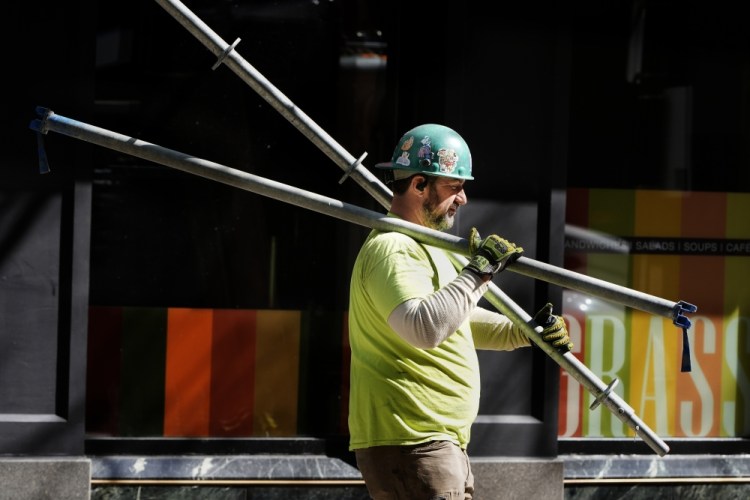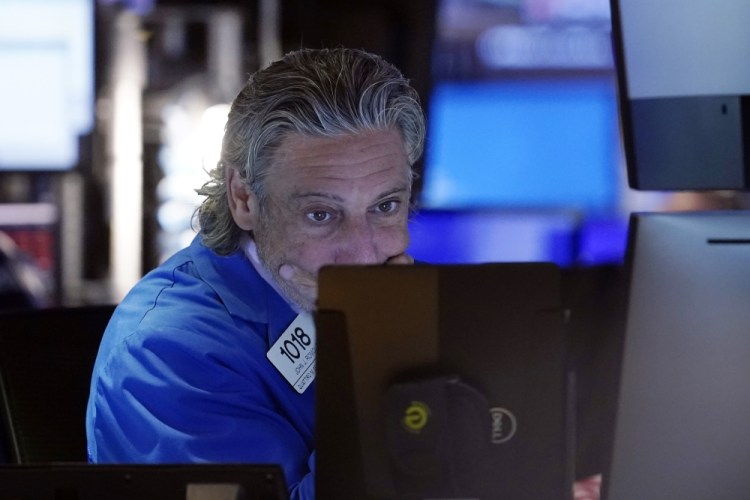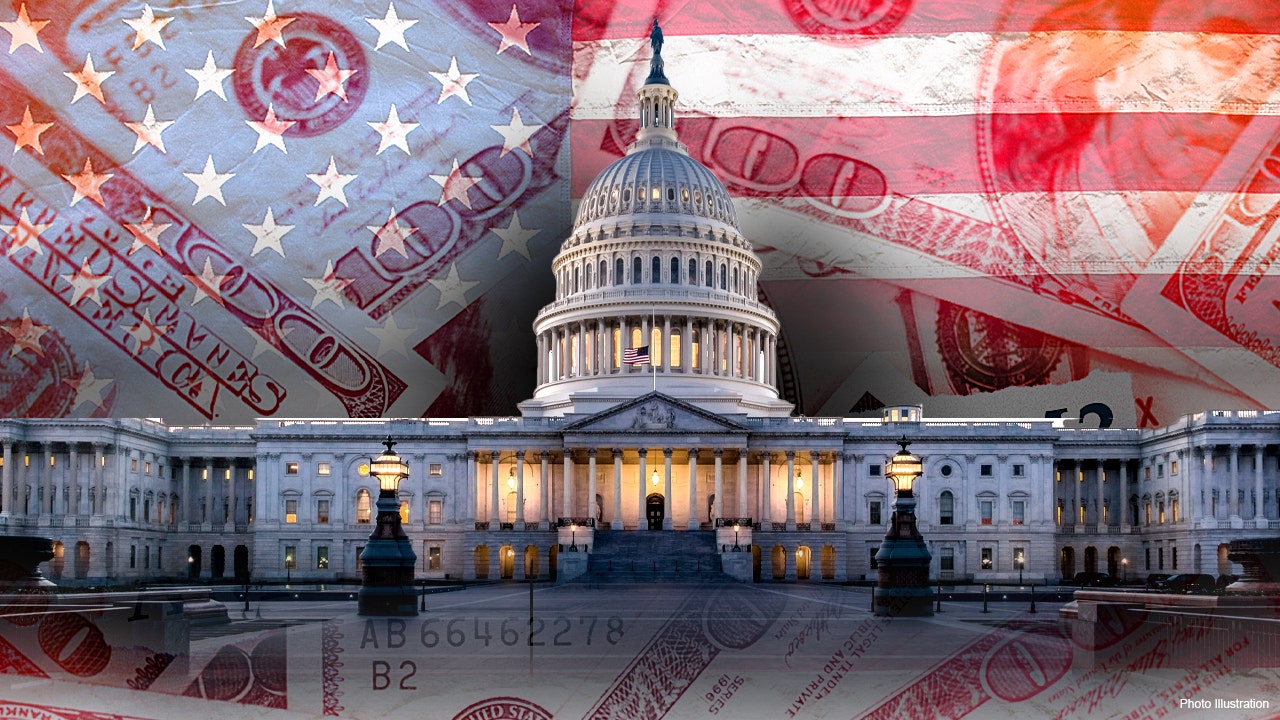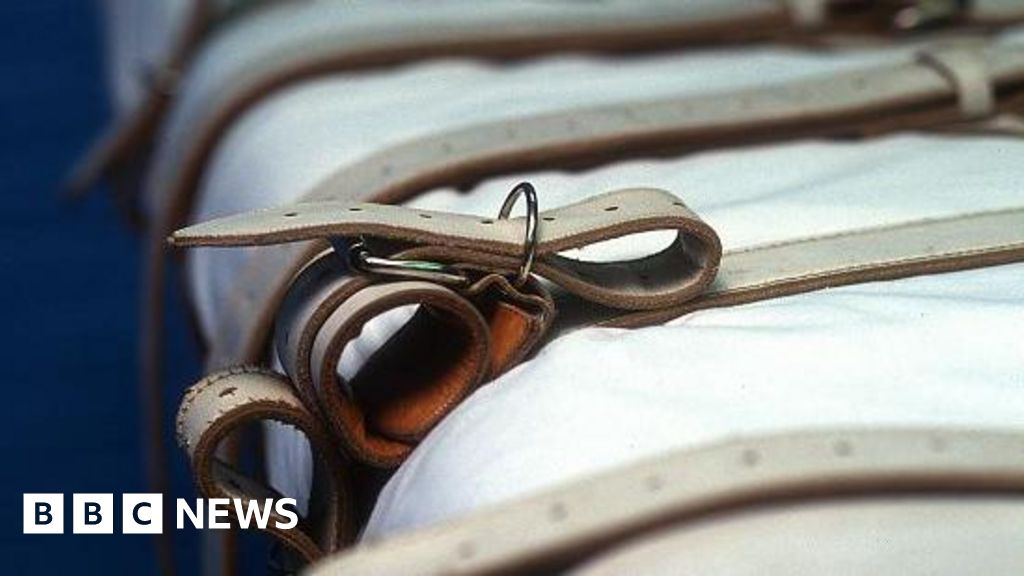
A construction worker carries scaffolding parts on March 14 in Boston. Michael Dwyer/Associated Press, file
WASHINGTON — The U.S. economy suffered an unexpected setback in July as hiring fell sharply and the unemployment rate rose for the fourth straight month, with sustained higher interest rates taking a toll on businesses and consumers.
Friday’s report from the Labor Department showed that employers added just 114,000 jobs in July – 35% fewer than forecasters had expected – and that unemployment, now up to 4.3%, is the highest since October 2021.
“Things are deteriorating quickly,” said Julia Pollak, chief economist at the job marketplace ZipRecruiter. The news shook financial markets around the world.
The sturdiness of the U.S. economy – the world’s largest – has been a key driver of global economic growth, and the U.S. jobs market is a big reason for it, underpinning the American expansion and giving consumers the confidence and financial wherewithal to keep spending
The unemployment rate’s jump to 4.3% in July crossed a tripwire that historically has signaled that the United States is in recession – though economists say the gauge probably is not reliable in the topsy-turvy postpandemic economy.
The S&P 500 fell 1.8% Friday for its first back-to-back loss of at least 1% since April. The Dow Jones Industrial Average lost 611 points, or 1.5%, and the Nasdaq composite fell 2.4% as a sell-off for stocks whipped all the way around the world back to Wall Street.
Hiring may have been disrupted by Hurricane Beryl, which slammed Texas and its economy last month. And ZipRecruiter’s Pollak noted that some employers have cut workers’ hours and put some on temporary layoffs – perhaps signaling that they are optimistic that Fed rate cuts will turn things around.
“They’re not cutting jobs outright,” she said. “They are just slowing hiring and putting people on temporary layoff, furlough. They want to get back to business. They see lots of opportunities to expand. They just need rates to be (lower).”
The weak jobs report came two days after the Federal Reserve said it would hold off on cutting interest rates until it sees more evidence that inflation is continuing to move down and closer to its 2% target. Fed Chair Jerome Powell characterized the American job market as healthy, despite growing calls for the central bank to begin lowering its benchmark rate, which stands at a 23-year high, to preempt a major weakening of the U.S. economy and job market.


Trader John Romolo works on the floor of the New York Stock Exchange on Friday. Richard Drew/Associated Press
In another sign that the labor market is cooling, average hourly wages rose just 3.6% from July 2023, the smallest year-over-year gain since May 2021 and a development likely to ease inflationary pressure in the economy.
Job gains were also concentrated in a few industries. Health care and social assistance firms added 64,000 jobs last month, accounting for 56% of hiring. Restaurants, hotels and bars added nearly 26,000 jobs.
Labor Department revisions also clipped 29,000 jobs from May and June payrolls. So far this year, the economy has generated nearly 203,000 jobs a month – solid but down from 251,000 last year, 377,000 in 2022 and a record 604,000 in 2021, when the job market roared back from pandemic lockdowns.
The economy is weighing heavily on voters’ minds as they prepare for the presidential election in November. Even before Friday’s disappointing hiring numbers, many had been unimpressed with the strong job gains of the past three years while being exasperated instead by high prices. Two years ago, inflation hit a four-decade high. The price increases eased, but consumers are still paying 19% more for goods and services overall than they were before inflation first heated up in spring 2021.
The so-called Sahm Rule, named for the former Fed economist who came up with it, Claudia Sahm, holds that a recession is almost always already underway if the unemployment rate (based on a three-month moving average) rises by half a percentage point from its low of the past year. The jump to 4.3% unemployment crossed the threshold.
Still, Sahm, now chief economist at the investment firm New Century Advisors, said before Friday’s report that this time “a recession is not imminent” even if the Sahm Rule were triggered. That is partly because America’s jobs numbers have been unsettled by an unexpected surge in immigration – much of it illegal – over the past couple of years.
The new arrivals have poured into the American labor force and helped ease labor shortages across the economy – but not all of them have found jobs right away, pushing up the jobless rate. Moreover, people who have entered the country illegally are less inclined to respond to the Labor Department’s jobs survey, meaning they can go uncounted as employed.
Sahm had urged Fed policymakers to cut their benchmark interest rate at their meeting this week, but they chose to leave it unchanged at the highest level in 23 years. They are widely expected to start reducing the rate at their next meeting in September.
On Wednesday, the Fed signaled that it would likely cut its benchmark interest rate at its next meeting in September from its current level of 5.3%, a 23-year high. The slowdown in hiring has spurred calls from economists and many investors for the Fed to implement a half-point cut rather than the more traditional quarter-point.
Powell downplayed that possibility at a news conference Wednesday, though he did not rule it out.
“I don’t want to be really specific about what we’re going to do, but that’s not something we’re thinking about right now,” the Fed chair said.
On Friday, the odds of a half-point cut soared in financial markets after the jobs report was released. Traders on Friday priced in a 63% chance of half-point cut, up from just 22% a day earlier, according to futures markets.
“The Fed has so much room to cut,” Pollak said.
Economists on Friday were questioning whether the Fed had waited too long to start easing borrowing costs.
“Oh dear, has the Fed made a policy mistake?” said Seema Shah, chief global strategist at Principal Asset Management. ”The labor market’s slowdown is now materializing with more clarity. A September rate cut is in the bag, and the Fed will be hoping that they haven’t, once again, been too slow to act.”
A break on borrowing costs could not come soon enough for many business owners.
Chris Maher is CEO of OceanFirst Bank in Red Bank, New Jersey, which works with 20,000 small businesses from restaurants and hotels to car dealerships. Maher said those businesses have pulled back on hiring since Memorial Day as its customers grow more cautious.
A Fed rate cut in September could boost businesses like home construction and car dealerships by cutting the cost of loans, leading to a pickup in hiring, Maher said, but he remains cautious.
At the Barrel Room, a San Francisco wine bar and restaurant, founder Sarah Trubnick is puzzled by what’s happening with the economy. After an “insanely busy” first three months of 2024, she had high hopes for the rest of the year. But business plummeted over the summer, and she doesn’t know why.
She had to lay off four workers and now has just 10 at the business she founded in 2011.
“We had been in business for many years,” she said. “So we were very familiar with the patterns, and we knew when to bring on more people, when to expect difficult times. And we knew we had to have a financial cushion at times. We had it all down to a science. And post-COVID, I can’t figure out the pattern.”
The Labor Department reported Thursday that 1.88 million Americans were collecting unemployment benefits the week of July 20, the most since November 2021 – and a sign that those without a job are likely struggling to find a new one.
Julian Cannon, 34, of New York, lost his job as a reporter at an online publication back in December. He’s applied for hundreds of jobs with no luck. One company interviewed him eight times for several positions, then ended up hiring a candidate who already worked there.
“I’m still looking, and I’m at a breaking point,” he said.
Related Stories











